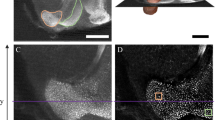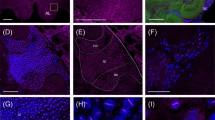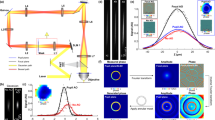Abstract
In a comment on our Article “Sublethal Dosage of Imidacloprid Reduces the Microglomerular Density of Honey Bee Mushroom Bodies”, Rössler et al. assert that our reported counts are overall lower than previously reported due to the use of automated quantification. We address these issues in this reply.
Similar content being viewed by others
Introduction
The earlier study reported by Groh et al.1 did not quantify the uneven distribution of the microglomeruli in the calyces, even though this appeared in their micrographs. We noticed that 4 selected areas within the so-called dense region of Fig. 1B clearly have more dense labelling when compared to the unselected central area1. This effect is also apparent in Fig. 1B in the Rössler et al. paper. Thus it seems clear that just by choosing a particular region of interest (Fig. 1B for confocal microscopy and Fig. 3A for EM in Groh et al.1) would cause bias. It was for this very reason therefore, that the entirety of the calyces was counted in our study. It is thus reasonable that our results showed that the densities are overall lower compared with previous reports due to the particular regions selected and methods used in those studies. In summary, earlier methods that assumed uniform density are difficult to compare with our method that comprehensively measured all regions, and thereby quantified the regional differences for the first time.
In our study, each calyce underwent a thorough scanning of the entire structure, and were later processed by software to count MGs2. The image was three-dimensional and was thus difficult to present how the MGs were distributed. Therefore, we chose as an example only one layer of the captured image to indicate the phenomenon. This one layer does not represent the whole picture of the distribution of microglomeruli in the calyces. The Fig. 1 in Rössler et al.’s paper used our example figure and put a yellow box on it intending to show the density of microglumerli in a volume of 10 μm × 10 μm × 10 μm. We do not think this is a proper method for comparison given that much less than the whole data set is used, the authors, again, ignore the uneven distribution of the microglomeruli in the calyces.
We were aware that the densities reported in our study are lower than previous research. But this contrast may be caused by the different counting methods, sampling methods and different populations etc. The foragers in our study were the ones carrying pollen on their corbiculate legs we collected outside the hive. Those foragers are elder than 20 days but younger than 30. It is possible that the young forgers of our study had a lower number of microglomeruli when compared with 35-day-old foragers in Groh et al.1. The purpose of our study was to compare the MG number and density before and after the imidacloprid treatment during the larval stage. Therefore, we must build new baselines for every region of the calyx so that we could compare before and after applying the same method and analyze the data statistically. The honey bees fed with sublethal dosages certainly show lower density of microglomeruli in the calyces than normal ones. The results showed a profound impact on their nervous system.
References
Groh, C., Lu, Z., Meinertzhagen, I. A. & Rössler, W. Age-related plasticity in the synaptic ultrastructure of neurons in the mushroom body calyx of the adult honeybee Apis mellifera. J. Comp. Neurol. 520, 3509–3527 (2012).
Peng, Y.-C. & Yang, E.-C. Sublethal Dosage of Imidacloprid Reduces the Microglomerular Density of Honey Bee Mushroom Bodies. 6, 19298 (2016).
Author information
Authors and Affiliations
Contributions
Y.C.P. and E.C.Y. wrote the main manuscript text. Both authors reviewed the manuscript.
Corresponding author
Ethics declarations
Competing Interests
The authors declare that they have no competing interests.
Additional information
Publisher's note: Springer Nature remains neutral with regard to jurisdictional claims in published maps and institutional affiliations.
Rights and permissions
Open Access This article is licensed under a Creative Commons Attribution 4.0 International License, which permits use, sharing, adaptation, distribution and reproduction in any medium or format, as long as you give appropriate credit to the original author(s) and the source, provide a link to the Creative Commons license, and indicate if changes were made. The images or other third party material in this article are included in the article’s Creative Commons license, unless indicated otherwise in a credit line to the material. If material is not included in the article’s Creative Commons license and your intended use is not permitted by statutory regulation or exceeds the permitted use, you will need to obtain permission directly from the copyright holder. To view a copy of this license, visit http://creativecommons.org/licenses/by/4.0/.
About this article
Cite this article
Peng, YC., Yang, EC. Reply to ‘Pitfalls of using confocal-microscopy based automated quantification of synaptic complexes in honeybee mushroom bodies (response to Peng and Yang 2016)’. Sci Rep 7, 11286 (2017). https://doi.org/10.1038/s41598-017-11858-x
Received:
Accepted:
Published:
DOI: https://doi.org/10.1038/s41598-017-11858-x
Comments
By submitting a comment you agree to abide by our Terms and Community Guidelines. If you find something abusive or that does not comply with our terms or guidelines please flag it as inappropriate.



